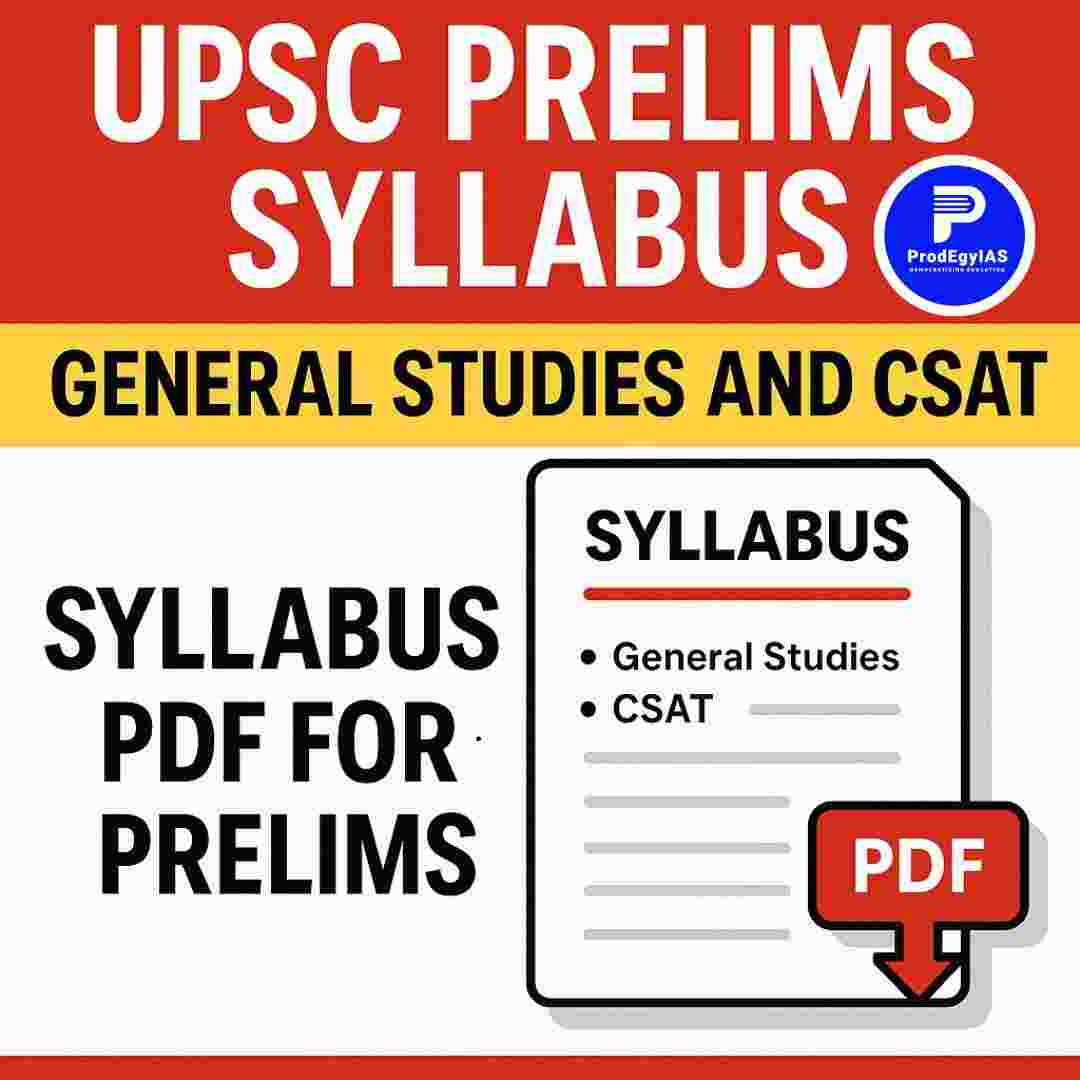UPSC Prelims Syllabus 2025 has been released by the exam officials in the information brochure along with the release of the UPSC exam notification 2025. Candidates aspiring to become civil servants need to clear the UPSC Prelims 2025 to sit for the Mains exam.

UPSC will conduct the UPSC CSE Prelims 2025 on May 25, 2025, at various exam centres across the nation. Candidates preparing for the exam need to thoroughly go through the specified UPSC CSE Prelims Syllabus to get the conceptual, analytical and theoretical knowledge of the syllabus.
UPSC Prelims syllabus consists of two parts namely UPSC Prelims General Paper (Paper 1) and UPSC CSAT Paper (Paper 2). The exam officials will test candidates’ domain understanding of the UPSC Prelims syllabus 2025 in the form of MCQs. As per the UPSC Exam Pattern, there will be 100 and 80 MCQ questions in Paper 1 and 2 and candidates will be given 120 minutes or 2 hours to answer in offline mode.
Check out the UPSC Prelims Syllabus 2025 in detail in this article:
UPSC Prelims Syllabus 2025: Overview
UPSC CSE Prelims Syllabus consists of two compulsory papers which are screening test in nature. The UPSC CSE exam 2025 is conducted to shortlist the candidates for the UPSC CSE Main Exam 2025. Check out the UPSC Syllabus Prelims overview here:
Specifications | Features |
Number of Papers | Paper 1: General Paper Paper 2: CSAT Paper |
Number of Questions | 180 Questions (200 questions each) 100 Questions (Paper 1) 80 Questions (Paper 2) |
Types of Questions | Multiple Choice Questions (MCQs) |
Total Maximum Marks | 400 Marks |
Duration of the Exam | 2 hours or 120 minutes for each paper (20 minutes per hour extra time for blind candidates & candidate with Locomotor Disability & Cerebral Palsy [minimum 40% impairment |
Negative Marking Scheme | ⅓ marks deduction |
Medium of the Exam | Bilingual (Hindi or English) |
UPSC Prelims Exam Pattern
Candidates can check out the UPSC Prelims exam pattern and negative marking scheme from here:
Paper | Type of Questions | Number of Question | Total Marks | Negative Marking Scheme | Exam Duration |
General Studies Paper (Paper 1) | MCQ | 100 | 100 | 1/3 | 2 Hours or 120 minutes |
CSAT (Paper 2) | MCQ | 80 | 100 | 1/3 | 2 hours or 120 minutes |
UPSC Prelims Syllabus 2025: General Paper
The UPSC Prelims GS I paper comprises topics from General Studies like History, Geography, Economy, polity and governance, general science, and most importantly, current affairs.
- Current events of national and international importance.
- History of India and Indian National Movement.
- Indian and World Geography-Physical, Social, Economic Geography of India and the World.
- Indian Polity and Governance-Constitution, Political System, Panchayati Raj, Public Policy, Rights Issues, etc.
- Economic and Social Development-Sustainable Development, Poverty, Inclusion, Demographics, Social Sector Initiatives, etc.
- General issues on Environmental ecology, Bio-diversity and Climate Change – that do not require subject specialization.
- General Science.
NOTE: The exam officials have just mentioned the topics that need to be covered, but didn’t mention the depth syllabus of each topic. After analysing the previous year trends, subtopics that need to be covered are mentioned below.
UPSC Prelims Syllabus for History
Check out the detailed UPSC Prelims Histrory Syallbus from here:
UPSC CSE Prelims Syllabus: History | |
Subject | Topics |
Ancient History |
1. Vedic texts- change from Rigvedic to later Vedic phases. 2. Religion- Upanishad thought-Political and social organisation, the evolution of the Varna system and monarchy.
|
Medieval History |
Founding by Babur (Battle of Panipat)
Iqta system, Mansabdari system
Sufi Movement (Chishti, Suhrawardi orders) Religious tolerance and syncretism under Akbar Art, Architecture, and Culture Indo-Islamic architecture (arches, domes, minarets)
Ibn Battuta, Marco Polo, Al-Biruni, Francois Bernier, Niccolò Manucci (Questions often come based on what they observed or wrote)
Caste, position of women, urbanization Trade and commerce (inland and maritime), guilds Agrarian economy and landholding patterns
Marathas (Shivaji, administration, military) Rajputs, Sikhs, Ahoms, Jats |
Modern History |
Phase 1: Moderate Phase (1885–1905) Formation of Indian National Congress (1885) Leaders: Dadabhai Naoroji, Gopal Krishna Gokhale, W.C. Bonnerjee Economic critique of British rule Phase 2: Extremist Phase (1905–1919) Partition of Bengal (1905), Swadeshi Movement Leaders: Bal Gangadhar Tilak, Bipin Chandra Pal, Lala Lajpat Rai Surat Split (1907) Ghadar Movement, Home Rule Leagues Phase 3: Gandhian Era (1919–1947) Rowlatt Act, Jallianwala Bagh Massacre Non-Cooperation Movement (1920) Civil Disobedience Movement (1930), Salt March Quit India Movement (1942) Gandhi-Irwin Pact, Round Table Conferences
Bhagat Singh, Chandrashekhar Azad, Hindustan Socialist Republican Association (HSRA)
Communist Party of India (formation, role) Trade union movements
Simon Commission (1927) Nehru Report, Jinnah’s 14 Points Cripps Mission (1942) Cabinet Mission Plan (1946) Mountbatten Plan, Indian Independence Act (1947)
Evolution of Indian polity under British rule Indian Councils Act to Government of India Act, 1935 Role of Constituent Assembly
Causes and impact of Partition Role of Indian National Army (INA), Subhas Chandra Bose |
UPSC Prelims Syllabus for Indian and World Geography
Check out the detailed UPSC Prelims Geography Syllabus from here:
Indian Geography
Physical Geography of India
- Geological structure of India
- Physiographic divisions: Himalayas, Northern Plains, Peninsular Plateau, Coastal Plains, Islands
- Rivers and Drainage systems (Ganga, Brahmaputra, Godavari, Krishna, etc.)
- Lakes and Waterfalls
- Climate: Monsoon, Seasons, Climatic regions
- Natural vegetation and forest types
- Soils of India (Black, Red, Alluvial, Laterite, etc.)
Resources
- Mineral Resources (iron, coal, bauxite, uranium, etc.)
- Energy Resources: Thermal, Hydel, Nuclear, Solar, Wind
- Water resources: Rivers, dams (Bhakra Nangal, Sardar Sarovar), interstate water disputes.
- Land use and Agriculture: Cropping patterns, irrigation, types of farming
Agriculture
- Major crops (rice, wheat, cotton, tea, coffee, etc.)
- Green Revolution, White Revolution, Blue Revolution
- Agricultural productivity and allied sectors (horticulture, fisheries)
Economic and Human Geography
- Population distribution and density
- Urbanization and migration
- Industries (Iron & Steel, IT, Textiles, Automobiles, etc.)
- Transportation (Roadways, Railways, Airways, Waterways)
- Trade and major ports
World Geography
Physical Geography
- Continents, Oceans, Major Mountains, Plateaus, Deserts, Rivers, Lakes
- Earth’s structure and interior (crust, mantle, core)
- Plate Tectonics, Earthquakes, Volcanoes
- Landforms created by rivers, wind, glaciers
- Climate types (Köppen classification)
Ocean currents and marine geography
- Biomes and natural vegetation (Tundra, Taiga, Tropical rainforest, etc.)
Human and Economic Geography
- Population: distribution, growth, and density
- Major regions of industrial development (USA, Europe, China)
- Agriculture: types (subsistence, commercial), global food crops
- Natural resources and their distribution globally (oil, coal, gold, etc.)
Geography Mapped to Current Affairs
1.Mapping questions (mountains, rivers, cities, conflicts, borders)
2. Environmental issues (deforestation, desertification, etc.
3. Climate change and international summits (COP meetings, IPCC reports)
4. Natural disasters (earthquakes, floods, cyclones) and their locations
5. Important international boundaries and disputed areas (e.g., Israel–Palestine, South China Sea, Russia–Ukraine)
UPSC Prelims Syllabus: Indian Polity and Governance
- Indian Constitution
- Historical background and making of the Constitution
- Preamble
- Salient features of the Constitution
- Union and its Territory
- Citizenship
- Fundamental Rights & Duties
- Directive Principles of State Policy (DPSP)
- Amendment of the Constitution (esp. 42nd, 44th, 73rd, 74th, 86th, 101st amendments)
- Important Schedules (esp. 6th, 7th, 8th, 9th, 10th, 11th, 12th)
- System of Government
- Parliamentary system vs Presidential system
- Federal structure
- Centre–State Relations
- Inter-State Council and other mechanisms
- Emergency Provisions (National, State, Financial)
- Special provisions for some states (e.g., Articles 370, 371)
- Union Government
- President, Vice-President
- Prime Minister and Council of Ministers
- Parliament: Lok Sabha, Rajya Sabha – powers, functions, procedures
- Parliamentary Committees
- Budget and Money Bills
- Attorney General, Comptroller & Auditor General (CAG)
- State Government
- Governor
- Chief Minister and State Council of Ministers
- State Legislature: Legislative Assembly & Council
- State Public Service Commission
- Judiciary
- Supreme Court – structure, powers, judicial review, PIL
- High Courts and Subordinate Courts
- Judicial Activism and Judicial Reforms
- Tribunals
- Local Self-Government
- 73rd Amendment – Panchayati Raj Institutions (PRI)
- 74th Amendment – Urban Local Bodies
- Structure, roles, powers, and finances
- Constitutional & Statutory Bodies
- Election Commission
- Finance Commission
- UPSC & State PSCs
- CAG, CVC, CIC, NHRC, SHRC, Lokpal and Lokayuktas
- NITI Aayog (non-constitutional)
- Governance and Public Policy
- Role of Civil Services in a Democracy
- Transparency and Accountability (RTI Act, Citizen Charter, E-governance)
- Welfare Schemes for vulnerable sections
- Rights-based legislations: Right to Education, Right to Information, MGNREGA
- Issues of Good Governance: Corruption, Red Tape, Accountability
- Rights Issues
- Human Rights
- Women and Child Rights
- Minority Rights
- SC/ST/OBC Rights
- LGBTQ+ legal developments (e.g., Section 377, Transgender Act)
- Tribals and forest rights
UPSC Prelims Syllabus: Indian Economy
- Basic Concepts of Economics
- GDP, GNP, NDP, NNP – at Factor Cost and Market Price
- Inflation – types, causes, and effects
- Fiscal Policy vs Monetary Policy
- Budgeting – types of deficits: Fiscal, Revenue, Primary
- Public Finance – taxation, expenditure, subsidies
- Indian Economy Overview
- Economic history and evolution post-independence
- Characteristics of the Indian economy (mixed, developing)
- Economic Planning in India (Five-Year Plans to NITI Aayog)
- National Income Accounting – data trends and sources (CSO, NSO)
- Government Budgeting
- Union Budget – structure, revenue & capital accounts
- Key concepts: FRBM Act, types of grants and funds
- Budget documents and terminology (e.g., Demands for Grants)
- Inflation and Price Stability
- CPI, WPI, IIP, Core Inflation
- Role of RBI in inflation control (repo rate, reverse repo, CRR, SLR)
- Monetary transmission mechanisms
- Banking and Financial Sector
- Structure of Indian Banking System – RBI, PSBs, NBFCs, RRBs, Payment Banks
- Financial inclusion initiatives – PMJDY, UPI, AEPS, NPCI
- NPA, Basel norms, Prompt Corrective Action
- Role of RBI – monetary policy tools, inflation targeting
- External Sector
- Balance of Payments (BoP)
- Current Account Deficit (CAD)
- Exchange rate regime in India
- FDI, FII, ECB – trends and regulations
- International institutions: IMF, World Bank, WTO
- Agriculture and Allied Sectors
- Agricultural finance, insurance (PMFBY), and subsidies
- MSP, APMC Act, Kisan Credit Card
- Land reforms and agrarian distress
- Allied sectors – fisheries, livestock, sericulture
- Industry and Infrastructure
- Industrial policies (1948, 1956, LPG reforms 1991)
- MSMEs, Make in India, Start-up India
- Infrastructure sectors: Roads, Railways, Aviation, Power
- Public-Private Partnerships (PPP) and NIP
- Poverty, Unemployment, and Inequality
- Types of unemployment (structural, frictional, disguised, seasonal)
- Poverty estimates and committees (Tendulkar, Rangarajan)
- Inclusive growth and Sustainable Development
- Government schemes: MGNREGA, NRLM, NSAP, PMAY
- Social Sector Initiatives
- Health, Education and Sanitation: NHM, Ayushman Bharat, NEP 2020, SBM
- Skill development and employment programmes
- Direct Benefit Transfer (DBT), JAM Trinity
- Sustainable Development & Environment-Economy Link
- SDGs, Green GDP, Carbon markets
- Climate finance and international agreements
- Current Affairs Related to Economy
- Economic Survey (key highlights)
- Budget (allocations, fiscal trends, new schemes)
- RBI reports, SEBI regulations
- Global economic trends affecting India (crude oil, US Fed decisions, etc.)
UPSC Prelims Syllabus: General Science
- Physics (Basic Concepts)
- Laws of Motion, Gravity, Work, Energy, and Power
- Heat, Temperature, and Thermodynamics
- Light – Reflection, Refraction, Dispersion, Optics
- Sound – properties and applications
- Electricity and Magnetism – Ohm’s Law, Electric Circuits, Current, Magnetic Effects
- Simple Machines – Levers, Inclined Plane, Pulleys
- Chemistry (Everyday Life and Basics)
- Structure of Atom, Elements, Compounds, and Mixtures
- Acids, Bases, and Salts – pH, reactions
- Chemical Reactions and Equations
- Metals and Non-Metals – properties and uses
- Carbon and Its Compounds – hydrocarbons, fuels, ethanol, soaps, detergents
- Polymers, Plastics, and Synthetic Fibres
- Environmental Chemistry – pollutants, ozone, acid rain, etc.
- Biology (Human Body & Environment)
- Cell structure and functions
- Human Digestive, Respiratory, Circulatory, Excretory, and Nervous systems
- Reproduction in Humans and Plants
- Genetics and Heredity – DNA, Mendel’s Laws (basic only)
- Health and Diseases – Communicable, Non-communicable diseases
- Vaccines, Antibiotics, Immunity
- Nutrition and Balanced Diet
- Science & Technology in Daily Life
- Scientific Instruments and their uses
- Applications of Satellites, Lasers, Fibre Optics
- Electricity in daily use – inverters, transformers, LED, solar panels
- Digital technologies – Bluetooth, Wi-Fi, GPS, QR codes, IoT
- Space and Defence Technology
- ISRO missions – Chandrayaan, Mangalyaan, Gaganyaan
- DRDO innovations
- Satellites – INSAT, NAVIC, GSAT, RISAT
- Ballistic missiles and defence systems (e.g., Agni, BrahMos, S-400)
- Biotechnology & Health
- DNA, RNA, Genetic Engineering, GM Crops
- Stem Cell Technology, Cloning
- COVID-19 vaccines, mRNA vaccines, herd immunity
- Biotechnology in agriculture and medicine
- National Health Programs (e.g., Ayushman Bharat, Mission Indradhanush)
- Environmental Science Integration
- Climate change, global warming, carbon cycle
- Renewable vs non-renewable resources
- Biodiversity, pollution control technologies
- Science-based current environmental issues
- Current Affairs-Based Science & Tech
- Nobel Prizes in science
- New vaccine technologies, medical research
- India’s scientific institutions – ISRO, BARC, CSIR, ICMR, DRDO
- Emerging technologies: AI, Robotics, Quantum Computing, 5G, Cybersecurity
UPSC Prelims Syllabus 2025: CSAT Paper
- Comprehension;
- Interpersonal skills including communication skills;
- Logical reasoning and analytical ability;
- Decision making and problem solving;
- General mental ability;
- Basic numeracy (numbers and their relations, orders of magnitude, etc.) (Class X level),
- Data interpretation (charts, graphs, tables, data sufficiency etc. — Class X level).
NOTE: Paper 2 or CSAT of the UPSC CSE Prelims 2025 is qualifying in nature with minimum qualifying marks fixed at 33%. The candidate must appear in both the Papers of Civil Services Prelims Exam for evaluation. Therefore a candidate will be disqualified in case he/she does not appear in both the papers of UPSC Prelims 2025.



